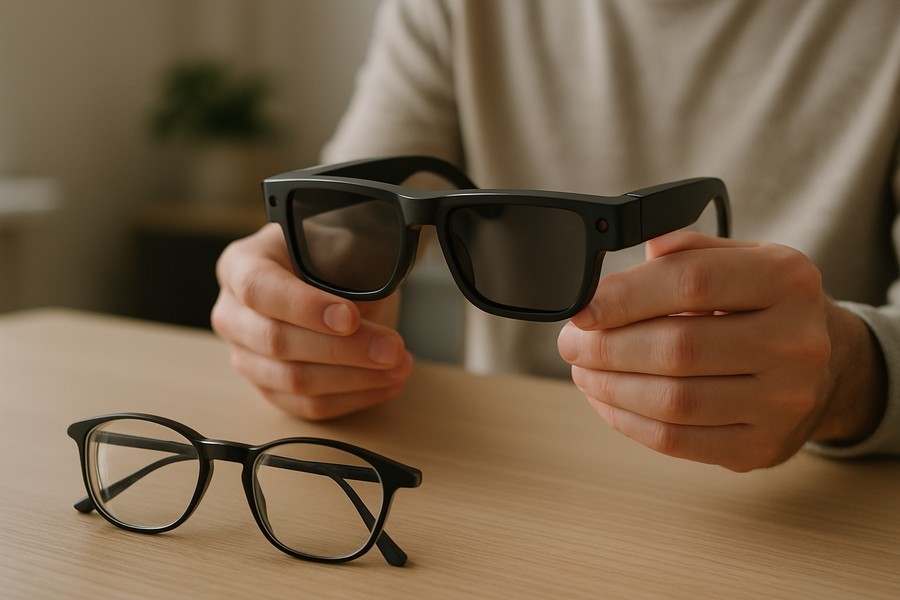
Decoding the Magic of High-Tech Eyewear
If you're not a fan of the second generation of high-tech glasses, it's likely that no smart glasses will ever impress you. I had the opportunity to review the first edition of these glasses, expressing my fondness for them. Despite some apprehensions related to privacy and technological affiliations, these glasses rose in popularity to become the top-selling smart glasses globally.
The company manufacturing the glasses, a known player in the eyewear industry, is set to produce a whopping 10 million units next year to meet the rising demand, thanks to the success of their smart glasses.
In this review, I aim to cater to two types of readers: the many who purchased the first-generation glasses and are contemplating whether to upgrade to the second, and those skeptics who are unsure whether to invest in smart glasses at all.
Understanding the Upgrade
For the first group, the difference between the first and second generation is subtle. Some issues have been addressed, while others remain. However, just like the first generation was improved significantly with AI and live AI features after its launch, the best of the second generation is yet to unfold. Patience will be key.
A Guide for Skeptics
The skeptics might be wondering if these high-tech glasses can replace the trio of sunglasses, earbuds, and smartphone cameras they currently use. The answer will depend largely on personal preferences and comfort with the hardware. If the glasses seem too bulky or heavy, it’s unlikely that any current smart glasses will appeal to you.
Styles, Specifications, and Pricing
The second generation glasses come in three styles, each with a variety of colors and lens options. They range in size to accommodate different head sizes. All styles and lens types can accommodate prescriptions, but only if ordered directly from the manufacturing company.
The starting price for all styles is $379, $80 more than the first generation. Additional costs are incurred for Polarized or Transitions lenses, which are $30 and $80 respectively. Purchasing directly from the manufacturer unlocks unique lens colors and additional features, like an optimized anti-reflective layer to combat smudges and oils.
What You'll Love
While many features are similar to the first generation, they're worth mentioning for new buyers. The glasses offer impressive speakers for music or audiobooks, a camera for first-person perspective photos, and a five-mic array for clear voice calls. A simple command activates the AI, providing a range of services from plant identification to reminder setting.
Although many of these functions can be performed by a smartphone and earbuds, the convenience of having them all in one package is undeniable. The design isn't flawless, but the partnership with the eyewear industry giant has been beneficial. The glasses, though slightly thick, look like regular eyewear with a variety of styles for individual preferences.
Camera and Video Capabilities
Camera quality remains the same as the first generation. The 12MP ultrawide sensor is excellent for moving targets and adjusts well to movement. However, without a wayfinder, it may be difficult to gauge what you're capturing or how close you should be. Also, the lack of alternative modes, like portrait, may limit photography options. Despite these drawbacks, the glasses excel at quick-snap, on-the-go photography.
What You Might Not Like
The glasses' size, both physically and aesthetically, may not be everyone's cup of tea. The bulky design necessary to house the cameras, mics, and battery is quite distinctive and may not suit everyone's style. It's recommended to try them on at a local store if you're unsure. Also, some may not appreciate the audio spill, as the music, at a volume sufficient for the wearer, can be heard by others nearby.
Should You Buy Them?
Consider buying the second-generation glasses if you're a first-generation user frustrated by the short battery life, an influencer or athlete who wants to capture and share live moments easily, or if one of the three styles suits your personal style. However, you might want to skip this upgrade if you're content with your current method of photography/music streaming, are waiting for other tech giants to release their smart glasses, or find them too bulky.
For newbies to smart glasses, the style, easy photography, and AI insights might be appealing, or they might be deterred by the size. The real question is whether first-generation or Stories owners will find enough improvements to upgrade. Longer battery life is a significant upgrade, and more enhancements are expected. If you're not convinced now, check back in a few months - they might be even better by then.
